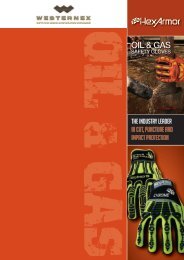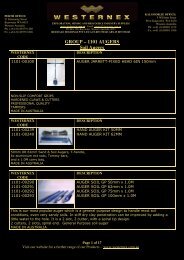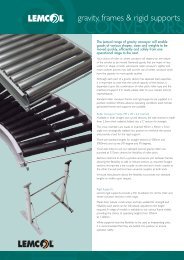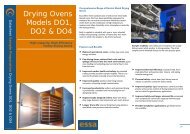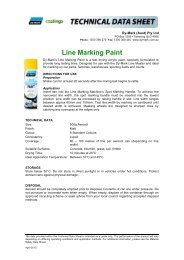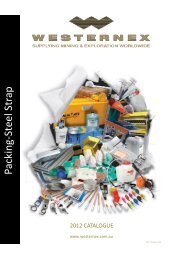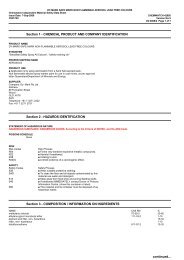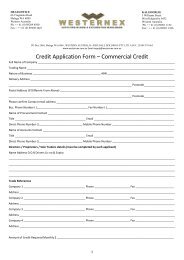Chemwatch Australian MSDS 22-0917 - Westernex
Chemwatch Australian MSDS 22-0917 - Westernex
Chemwatch Australian MSDS 22-0917 - Westernex
You also want an ePaper? Increase the reach of your titles
YUMPU automatically turns print PDFs into web optimized ePapers that Google loves.
continued...<br />
DY-MARK MINE MARKING NON FLAMMABLE AEROSOL FLUORESCENT<br />
<strong>Chemwatch</strong> Independent Material Safety Data Sheet<br />
Issue Date: 3-Sep-2010 CHEMWATCH <strong>22</strong>-<strong>0917</strong><br />
C9317EC<br />
Version No:3<br />
CD 2010/3 Page 1 of 7<br />
Section 1 - CHEMICAL PRODUCT AND COMPANY IDENTIFICATION<br />
PRODUCT NAME<br />
DY-MARK MINE MARKING NON FLAMMABLE AEROSOL FLUORESCENT<br />
SYNONYMS<br />
"Mine Marking Non Flammable Aerosol - Fluorescent Colours"<br />
PROPER SHIPPING NAME<br />
AEROSOLS<br />
PRODUCT USE<br />
■ Application is by spray atomisation from a hand held aerosol pack.<br />
Used according to manufacturer's directions.<br />
SUPPLIER<br />
Company: Dy- Mark Pty Ltd<br />
Address:<br />
89 Formation Street<br />
Wacol<br />
QLD, 4076<br />
Australia<br />
Telephone: +61 7 3271 <strong>22</strong><strong>22</strong><br />
Fax: +61 7 3271 2751<br />
Section 2 - HAZARDS IDENTIFICATION<br />
STATEMENT OF HAZARDOUS NATURE<br />
HAZARDOUS SUBSTANCE. DANGEROUS GOODS. According to NOHSC Criteria, and ADG Code.<br />
RISK<br />
Risk Codes<br />
R<strong>22</strong><br />
R38<br />
R40(3)<br />
R44<br />
SAFETY<br />
Safety Codes<br />
S23<br />
S51<br />
S09<br />
S53<br />
S401<br />
S07<br />
S13<br />
S26<br />
S46<br />
S60<br />
Risk Phrases<br />
■ Harmful if swallowed.<br />
■ Irritating to skin.<br />
■ Limited evidence of a carcinogenic effect.<br />
■ Risk of explosion if heated under confinement.<br />
Safety Phrases<br />
■ Do not breathe gas/fumes/vapour/spray.<br />
■ Use only in well ventilated areas.<br />
■ Keep container in a well ventilated place.<br />
■ Avoid exposure - obtain special instructions before use.<br />
■ To clean the floor and all objects contaminated by this<br />
material, use water and detergent.<br />
■ Keep container tightly closed.<br />
■ Keep away from food, drink and animal feeding stuffs.<br />
■ In case of contact with eyes, rinse with plenty of water<br />
and contact Doctor or Poisons Information Centre.<br />
■ If swallowed, IMMEDIATELY contact Doctor or Poisons<br />
Information Centre. (show this container or label).<br />
■ This material and its container must be disposed of as<br />
hazardous waste.<br />
Section 3 - COMPOSITION / INFORMATION ON INGREDIENTS<br />
NAME CAS RN %<br />
methylene chloride 75-09-2 30-60<br />
pigment and filler, non- hazardous 10-30<br />
resin, non- hazardous 1-10<br />
tetrafluoroethane 811-97-2 10-30<br />
Section 4 - FIRST AID MEASURES<br />
SWALLOWED<br />
■ - Not considered a normal route of entry.<br />
■ - For advice, contact a Poisons Information Centre or a doctor.
continued...<br />
DY-MARK MINE MARKING NON FLAMMABLE AEROSOL FLUORESCENT<br />
<strong>Chemwatch</strong> Independent Material Safety Data Sheet<br />
Issue Date: 3-Sep-2010 CHEMWATCH <strong>22</strong>-<strong>0917</strong><br />
C9317EC<br />
Version No:3<br />
CD 2010/3 Page 2 of 7<br />
Section 4 - FIRST AID MEASURES<br />
■ - Avoid giving milk or oils.<br />
■ - Avoid giving alcohol.<br />
EYE<br />
■ If aerosols come in contact with the eyes:<br />
- Immediately hold the eyelids apart and flush the eye continuously for at least 15 minutes with fresh running water.<br />
- Ensure complete irrigation of the eye by keeping eyelids apart and away from eye and moving the eyelids by occasionally lifting the upper and lower<br />
lids.<br />
- Transport to hospital or doctor without delay.<br />
- Removal of contact lenses after an eye injury should only be undertaken by skilled personnel.<br />
SKIN<br />
■ If solids or aerosol mists are deposited upon the skin:<br />
- Flush skin and hair with running water (and soap if available).<br />
- Remove any adhering solids with industrial skin cleansing cream.<br />
- DO NOT use solvents.<br />
- Seek medical attention in the event of irritation.<br />
INHALED<br />
■ If aerosols, fumes or combustion products are inhaled:<br />
- Remove to fresh air.<br />
- Lay patient down. Keep warm and rested.<br />
- Prostheses such as false teeth, which may block airway, should be removed, where possible, prior to initiating first aid procedures.<br />
- If breathing is shallow or has stopped, ensure clear airway and apply resuscitation, preferably with a demand valve resuscitator, bag-valve mask<br />
device, or pocket mask as trained. Perform CPR if necessary.<br />
NOTES TO PHYSICIAN<br />
■ for poisons (where specific treatment regime is absent):<br />
--------------------------------------------------------------<br />
BASIC TREATMENT<br />
--------------------------------------------------------------<br />
- Establish a patent airway with suction where necessary.<br />
- Watch for signs of respiratory insufficiency and assist ventilation as necessary.<br />
- Administer oxygen by non-rebreather mask at 10 to 15 L/min.<br />
- Monitor and treat, where necessary, for pulmonary oedema .<br />
for intoxication due to Freons/ Halons;<br />
A: Emergency and Supportive Measures<br />
- Maintain an open airway and assist ventilation if necessary<br />
- Treat coma and arrhythmias if they occur. Avoid (adrenaline) epinephrine or other sympathomimetic amines that may precipitate ventricular<br />
arrhythmias. Tachyarrhythmias caused by increased myocardial sensitisation may be treated with propranolol, 1-2 mg IV or esmolol 25-100<br />
microgm/kg/min IV.<br />
- Monitor the ECG for 4-6 hours<br />
B: Specific drugs and antidotes:<br />
- There is no specific antidote.<br />
Treat symptomatically.<br />
Section 5 - FIRE FIGHTING MEASURES<br />
EXTINGUISHING MEDIA<br />
■ SMALL FIRE: Use extinguishing agent suitable for type of surrounding fire.<br />
LARGE FIRE: Cool cylinder.<br />
DO NOT direct water at source of leak or venting safety devices as icing may occur.<br />
SMALL FIRE:<br />
- Water spray, dry chemical or CO2<br />
LARGE FIRE:<br />
- Water spray or fog.<br />
FIRE FIGHTING<br />
■ - Alert Fire Brigade and tell them location and nature of hazard.<br />
- May be violently or explosively reactive.<br />
- Wear breathing apparatus plus protective gloves.<br />
- Prevent, by any means available, spillage from entering drains or water course.<br />
When any large container (including road and rail tankers) is involved in a fire,<br />
consider evacuation by 100 metres in all directions.<br />
FIRE/EXPLOSION HAZARD<br />
■ - Non combustible.<br />
- Not considered to be a significant fire risk.<br />
- Heating may cause expansion or decomposition leading to violent rupture of containers.<br />
- Aerosol cans may explode on exposure to naked flames.<br />
Decomposition may produce toxic fumes of: carbon monoxide (CO).<br />
Combustion products include: carbon dioxide (CO2), hydrogen chloride, phosgene, hydrogen fluoride, other pyrolysis products typical of burning<br />
organic material.<br />
Contains low boiling substance: Closed containers may rupture due to pressure buildup under fire conditions.<br />
FIRE INCOMPATIBILITY<br />
■ - Avoid contamination with oxidising agents i.e. nitrates, oxidising acids, chlorine bleaches, pool chlorine etc. as ignition may result.<br />
HAZCHEM<br />
2YE
continued...<br />
DY-MARK MINE MARKING NON FLAMMABLE AEROSOL FLUORESCENT<br />
<strong>Chemwatch</strong> Independent Material Safety Data Sheet<br />
Issue Date: 3-Sep-2010 CHEMWATCH <strong>22</strong>-<strong>0917</strong><br />
C9317EC<br />
Version No:3<br />
CD 2010/3 Page 3 of 7<br />
Section 5 - FIRE FIGHTING MEASURES<br />
Personal Protective Equipment<br />
Breathing apparatus.<br />
Gas tight chemical resistant suit.<br />
Limit exposure duration to 1 BA set 30 mins.<br />
Section 6 - ACCIDENTAL RELEASE MEASURES<br />
MINOR SPILLS<br />
■ - Clean up all spills immediately.<br />
- Avoid breathing vapours and contact with skin and eyes.<br />
- Wear protective clothing, impervious gloves and safety glasses.<br />
- Shut off all possible sources of ignition and increase ventilation.<br />
MAJOR SPILLS<br />
■ - Remove leaking cylinders to a safe place.<br />
- Fit vent pipes. Release pressure under safe, controlled conditions<br />
- Burn issuing gas at vent pipes.<br />
- DO NOT exert excessive pressure on valve; DO NOT attempt to operate damaged valve.<br />
- Clear area of personnel and move upwind.<br />
- Alert Fire Brigade and tell them location and nature of hazard.<br />
- May be violently or explosively reactive.<br />
- Wear breathing apparatus plus protective gloves.<br />
Personal Protective Equipment advice is contained in Section 8 of the <strong>MSDS</strong>.<br />
Section 7 - HANDLING AND STORAGE<br />
PROCEDURE FOR HANDLING<br />
■ - Avoid all personal contact, including inhalation.<br />
- Wear protective clothing when risk of exposure occurs.<br />
- Use in a well-ventilated area.<br />
- Prevent concentration in hollows and sumps.<br />
SUITABLE CONTAINER<br />
■ - DO NOT use aluminium or galvanised containers.<br />
- Aerosol dispenser.<br />
- Check that containers are clearly labelled.<br />
STORAGE INCOMPATIBILITY<br />
■ Methylene chloride<br />
- is a combustible liquid under certain circumstances even though there is no measurable flash point and it is difficult to ignite<br />
- its is flammable in ambient air in the range 12-23%; increased oxygen content can greatly enhance fire and explosion potential<br />
- contact with hot surfaces and elevated temperatures can form fumes of hydrogen chloride and phosgene<br />
- reacts violently with active metals, aluminium, lithium, methanol,, peroxydisulfuryl difluoride, potassium, potassium tert-butoxide, sodium.<br />
Haloalkanes:<br />
- are highly reactive:some of the more lightly substituted lower members are highly flammable; the more highly substituted may be used as fire<br />
suppressants, not always with the anticipated results.<br />
- may react with the lighter divalent metals to produce more reactive compounds analogous to Grignard reagents.<br />
- may produce explosive compounds following prolonged contact with metallic or other azides<br />
- may react on contact with potassium or its alloys - although apparently stable on contact with a wide rage of halocarbons, reaction products may<br />
be shock-sensitive and may explode with great violence on light impact; severity generally increases with the degree of halocarbon substitution and<br />
potassium-sodium alloys give extremely sensitive mixtures .<br />
- Segregate from alcohol, water.<br />
- Compressed gases may contain a large amount of kinetic energy over and above that potentially available from the energy of reaction produced by the<br />
gas in chemical reaction with other substances.<br />
STORAGE REQUIREMENTS<br />
■ - Keep dry to avoid corrosion of cans. Corrosion may result in container perforation and internal pressure may eject contents of can.<br />
Section 8 - EXPOSURE CONTROLS / PERSONAL PROTECTION<br />
EXPOSURE CONTROLS<br />
Source Material TWA ppm TWA mg/m³ Notes<br />
___________ ___________ _______ _______ _______<br />
Australia Exposure methylene chloride 50 174 Sk<br />
Standards<br />
(Methylene chloride)<br />
Australia Exposure tetrafluoroethane (1, 1, 1, 1000 4240<br />
Standards<br />
2- Tetrafluoroethane)
continued...<br />
DY-MARK MINE MARKING NON FLAMMABLE AEROSOL FLUORESCENT<br />
<strong>Chemwatch</strong> Independent Material Safety Data Sheet<br />
Issue Date: 3-Sep-2010 CHEMWATCH <strong>22</strong>-<strong>0917</strong><br />
C9317EC<br />
Version No:3<br />
CD 2010/3 Page 4 of 7<br />
Section 8 - EXPOSURE CONTROLS / PERSONAL PROTECTION<br />
PERSONAL PROTECTION<br />
RESPIRATOR<br />
Type GAX Filter of sufficient capacity<br />
EYE<br />
■ No special equipment for minor exposure i.e. when handling small quantities.<br />
OTHERWISE: For potentially moderate or heavy exposures:<br />
- Safety glasses with side shields.<br />
- NOTE: Contact lenses pose a special hazard; soft lenses may absorb irritants and ALL lenses concentrate them.<br />
HANDS/FEET<br />
■ - No special equipment needed when handling small quantities.<br />
- OTHERWISE:<br />
- For potentially moderate exposures:<br />
- Wear general protective gloves, eg. light weight rubber gloves.<br />
OTHER<br />
■ No special equipment needed when handling small quantities.<br />
OTHERWISE:<br />
- Overalls.<br />
- Skin cleansing cream.<br />
- Eyewash unit.<br />
- Do not spray on hot surfaces.<br />
ENGINEERING CONTROLS<br />
■ General exhaust is adequate under normal conditions. If risk of overexposure exists, wear SAA approved respirator.<br />
Provide adequate ventilation in warehouse or closed storage areas.<br />
Section 9 - PHYSICAL AND CHEMICAL PROPERTIES<br />
APPEARANCE<br />
Coloured liquid; does not mix with water.<br />
PHYSICAL PROPERTIES<br />
Gas.<br />
Does not mix with water.<br />
State COMPRESSED GAS Molecular Weight Not Applicable<br />
Melting Range (°C) Not Available Viscosity Not Available<br />
Boiling Range (°C) Not Available Solubility in water (g/L) Immiscible<br />
Flash Point (°C) Not Available pH (1% solution) Not Applicable<br />
Decomposition Temp (°C) Not Available pH (as supplied) Not Applicable<br />
Autoignition Temp (°C) Not Available Vapour Pressure (kPa) Not Available<br />
Upper Explosive Limit (%) Not Available Specific Gravity (water=1) Not Available<br />
Lower Explosive Limit (%) Not Available Relative Vapour Density Not Available<br />
(air=1)<br />
Volatile Component (%vol) Not Available Evaporation Rate Not Available<br />
methylene chloride<br />
■ log Kow (Prager 1995): 1.25<br />
Section 10 - CHEMICAL STABILITY AND REACTIVITY INFORMATION<br />
CONDITIONS CONTRIBUTING TO INSTABILITY<br />
■ - Elevated temperatures.<br />
- Presence of open flame.<br />
- Product is considered stable.<br />
- Hazardous polymerisation will not occur.<br />
For incompatible materials - refer to Section 7 - Handling and Storage.<br />
Section 11 - TOXICOLOGICAL INFORMATION<br />
POTENTIAL HEALTH EFFECTS<br />
ACUTE HEALTH EFFECTS<br />
■ Harmful if swallowed.<br />
■ Irritating to skin.<br />
■ Vapours may cause dizziness or suffocation.<br />
CHRONIC HEALTH EFFECTS<br />
■ Limited evidence of a carcinogenic effect.<br />
TOXICITY AND IRRITATION<br />
■ unless otherwise specified data extracted from RTECS - Register of Toxic Effects of Chemical Substances.<br />
■ The material may produce moderate eye irritation leading to inflammation. Repeated or prolonged exposure to irritants may produce conjunctivitis.
continued...<br />
DY-MARK MINE MARKING NON FLAMMABLE AEROSOL FLUORESCENT<br />
<strong>Chemwatch</strong> Independent Material Safety Data Sheet<br />
Issue Date: 3-Sep-2010 CHEMWATCH <strong>22</strong>-<strong>0917</strong><br />
C9317EC<br />
Version No:3<br />
CD 2010/3 Page 5 of 7<br />
Section 11 - TOXICOLOGICAL INFORMATION<br />
The material may produce severe skin irritation after prolonged or repeated exposure, and may produce a contact dermatitis (nonallergic). This form<br />
of dermatitis is often characterised by skin redness (erythema) thickening of the epidermis.60% vol 4 h *<br />
* with added oxygen - ZhongHao New Chemical Materials <strong>MSDS</strong><br />
Excessive concentration can have a narcotic effect; inhalation of high concentrations of decomposition products can cause lung oedema.<br />
CARCINOGEN<br />
Dichloromethane International Agency for Research on Cancer Group 2B<br />
(methylene chloride)<br />
(IARC) - Agents Reviewed by the IARC<br />
Monographs<br />
REPROTOXIN<br />
methylene chloride ILO Chemicals in the electronics industry Reduced fertility or<br />
that have toxic effects on reproduction<br />
sterility<br />
Section 12 - ECOLOGICAL INFORMATION<br />
This material and its container must be disposed of as hazardous waste.<br />
Ecotoxicity<br />
Ingredient Persistence: Persistence: Air Bioaccumulation Mobility<br />
Water/Soil<br />
methylene chloride LOW HIGH LOW HIGH<br />
tetrafluoroethane HIGH LOW HIGH<br />
Section 13 - DISPOSAL CONSIDERATIONS<br />
■ - DO NOT allow wash water from cleaning or process equipment to enter drains.<br />
- It may be necessary to collect all wash water for treatment before disposal.<br />
- In all cases disposal to sewer may be subject to local laws and regulations and these should be considered first.<br />
- Where in doubt contact the responsible authority.<br />
- Consult State Land Waste Management Authority for disposal.<br />
- Discharge contents of damaged aerosol cans at an approved site.<br />
- Allow small quantities to evaporate.<br />
- DO NOT incinerate or puncture aerosol cans.<br />
Section 14 - TRANSPORTATION INFORMATION<br />
NON-FLAMMABLE<br />
NON-TOXIC<br />
GAS<br />
2<br />
Labels Required: NON-FLAMMABLE COMPRESSED GAS<br />
HAZCHEM:<br />
2YE (ADG7)<br />
ADG7:<br />
Class or division: 2 Subsidiary risk: None<br />
UN No.: 1950 UN packing group: None<br />
Special provisions: 63; 190; 277; 327; 344 Packing Instructions: None
continued...<br />
DY-MARK MINE MARKING NON FLAMMABLE AEROSOL FLUORESCENT<br />
<strong>Chemwatch</strong> Independent Material Safety Data Sheet<br />
Issue Date: 3-Sep-2010 CHEMWATCH <strong>22</strong>-<strong>0917</strong><br />
C9317EC<br />
Version No:3<br />
CD 2010/3 Page 6 of 7<br />
Section 14 - TRANSPORTATION INFORMATION<br />
Limited quantities: See SP 277 Portable tanks and bulk None<br />
containers -<br />
Instructions:<br />
Portable tanks and bulk None Packagings and IBCs - P003; LP02<br />
containers - Special<br />
Packing instruction:<br />
provisions:<br />
Packagings and IBCs -<br />
PP17, PP87, L2<br />
Special packing<br />
provisions:<br />
Shipping Name:AEROSOLS<br />
Land Transport UNDG:<br />
Class or division: 2 Subsidiary risk: None<br />
UN No.: 1950 UN packing group: None<br />
Shipping Name:AEROSOLS<br />
Air Transport IATA:<br />
ICAO/IATA Class: 2.2 ICAO/IATA Subrisk: None<br />
UN/ID Number: 1950 Packing Group: -<br />
Special provisions:<br />
A98<br />
Cargo Only<br />
Packing Instructions: 203 Maximum Qty/Pack: 150 kg<br />
Passenger and Cargo<br />
Passenger and Cargo<br />
Packing Instructions: 203 Maximum Qty/Pack: 75 kg<br />
Passenger and Cargo<br />
Passenger and Cargo<br />
Limited Quantity<br />
Limited Quantity<br />
Packing Instructions: Y203 Maximum Qty/Pack: 30 kg G<br />
Shipping Name: AEROSOLS, NON-FLAMMABLE<br />
Maritime Transport IMDG:<br />
IMDG Class: 2 IMDG Subrisk: SP63<br />
UN Number: 1950 Packing Group: None<br />
EMS Number: F- D , S- U Special provisions: 63 190 277 327 959<br />
Limited Quantities:<br />
See SP277<br />
Shipping Name: AEROSOLS<br />
POISONS SCHEDULE None<br />
REGULATIONS<br />
Regulations for ingredients<br />
Section 15 - REGULATORY INFORMATION<br />
methylene chloride (CAS: 75-09-2) is found on the following regulatory lists;<br />
"Australia - <strong>Australian</strong> Capital Territory - Environment Protection Regulation: Ambient environmental standards (Domestic water supply - organic<br />
compounds)","Australia - <strong>Australian</strong> Capital Territory - Environment Protection Regulation: Pollutants entering waterways taken to cause environmental<br />
harm (Aquatic habitat)","Australia - <strong>Australian</strong> Capital Territory Environment Protection Regulation Ecosystem maintenance - Organic chemicals - Nonpesticide<br />
anthropogenic organics","Australia - <strong>Australian</strong> Capital Territory Environment Protection Regulation Pollutants entering waterways -<br />
Domestic water quality","Australia Exposure Standards","Australia Hazardous Substances","Australia High Volume Industrial Chemical List (HVICL)",<br />
"Australia Inventory of Chemical Substances (AICS)","Australia National Pollutant Inventory","Australia Standard for the Uniform Scheduling of Drugs<br />
and Poisons (SUSDP) - Appendix E (Part 2)","Australia Standard for the Uniform Scheduling of Drugs and Poisons (SUSDP) - Appendix F (Part 3)",<br />
"Australia Standard for the Uniform Scheduling of Drugs and Poisons (SUSDP) - Appendix I","Australia Standard for the Uniform Scheduling of Drugs and<br />
Poisons (SUSDP) - Schedule 5","GESAMP/EHS Composite List - GESAMP Hazard Profiles","IMO IBC Code Chapter 17: Summary of minimum requirements","IMO<br />
MARPOL 73/78 (Annex II) - List of Noxious Liquid Substances Carried in Bulk","International Agency for Research on Cancer (IARC) - Agents Reviewed by<br />
the IARC Monographs","International Council of Chemical Associations (ICCA) - High Production Volume List","OECD Representative List of High<br />
Production Volume (HPV) Chemicals","WHO Guidelines for Drinking-water Quality - Guideline values for chemicals that are of health significance in<br />
drinking-water"<br />
tetrafluoroethane (CAS: 811-97-2) is found on the following regulatory lists;<br />
"Australia Exposure Standards","Australia Hazardous Substances","Australia High Volume Industrial Chemical List (HVICL)","Australia Inventory of<br />
Chemical Substances (AICS)","OECD Representative List of High Production Volume (HPV) Chemicals"<br />
No data for DY-MARK Mine Marking Non Flammable Aerosol Fluorescent (CW: <strong>22</strong>-<strong>0917</strong>)<br />
Section 16 - OTHER INFORMATION<br />
■ Classification of the preparation and its individual components has drawn on official and authoritative sources as well as independent review by<br />
the <strong>Chemwatch</strong> Classification committee using available literature references.<br />
A list of reference resources used to assist the committee may be found at:<br />
www.chemwatch.net/references.<br />
■ The (M)SDS is a Hazard Communication tool and should be used to assist in the Risk Assessment. Many factors determine whether the reported Hazards<br />
are Risks in the workplace or other settings.<br />
This document is copyright. Apart from any fair dealing for the purposes of private study, research, review or<br />
criticism, as permitted under the Copyright Act, no part may be reproduced by any process without written<br />
permission from CHEMWATCH. TEL (+61 3) 9572 4700.
DY-MARK MINE MARKING NON FLAMMABLE AEROSOL FLUORESCENT<br />
<strong>Chemwatch</strong> Independent Material Safety Data Sheet<br />
Issue Date: 3-Sep-2010 CHEMWATCH <strong>22</strong>-<strong>0917</strong><br />
C9317EC<br />
Version No:3<br />
CD 2010/3 Page 7 of 7<br />
Section 16 - OTHER INFORMATION<br />
Issue Date: 3-Sep-2010<br />
Print Date: 6-Sep-2010<br />
This is the end of the <strong>MSDS</strong>.




